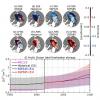The Tropical Pacific Decadal Variability (TPDV) Working Group of the CLIVAR Pacific Region Panel recently published a review paper that evaluates our understanding of the mechanisms behind TPDV. No final consensus exists on the relative importance and efficacy of the mechanisms, but the tropical ocean adjustment to varying wind forcing likely plays a key role in the origin of decadal timescales. These processes are elucidated in this review paper which is a product of rigorous discussions at several virtual meetings over the span of two years since the working group’s establishment in May 2021.
Science Highlights
Please have a look at the Guidelines for Science Highlights
Researchers from the Ocean and Atmosphere Studies Laboratory (LOA), National Institute for Space Research (INPE) and collaborators, published the article “Oceanic SACZ produces an abnormally wet 2021/2022 rainy season in South America”, in Scientific Reports.
Marine heatwaves (MHWs) are events characterized by prolonged and extremely warm ocean conditions, and have been detected in recent decades over many regions of the global ocean. Some recent studies led by D. Mawren and with the contribution from J. Hermes (co-chair of IORP), provide an improved understanding of the important role of horizontal advection, associated with anticyclonic eddies on the evolution of MHWs, as well as the co-occurring extremes in the Mozambique Channel.
A recent study led by Dr. Lijing Cheng, a member of the CLIVAR Global Synthesis and Observations Panel (GSOP), indicated that 2022 was another year of record heat for the oceans.
A perspective paper discussing how the research community can promote the enhancement of marine ecosystem forecasting using physical ocean conditions predicted by the GCMs has recently been published in Frontiers in Marine Science by scientists from CLIVAR and PICES communities.
A cloud-based analysis framework proposed by the Pangeo project was used to systematically assess the realism of the kilometer-scale resolution models, aiming to tackle the existed distribution and analysis challenges of the model output.
Recently, together with colleagues, two members from CLIVAR Ocean Model Development Panel (OMDP) conducted a comprehensive analysis on the Arctic sea surface salinity (SSS), liquid freshwater content (LFWC) and freshwater budget by comparing the CMIP6 to the CMIP5 results, showing that the salinity of the Barents Sea Opening is projected to keep declining in the future.
A recent paper on this subject by researchers at the University Complutense of Madrid examines the role of tropical convection, specially the location of the Inter Tropical Convergence Zone (ITCZ), in the occurrence of the two main tropical Atlantic-to-tropical Pacific basin interactions: the equatorial Atlantic to equatorial Pacific teleconnection, and the North Tropical Atlantic to equatorial Pacific teleconnection.
Aiming to account for the Polar Amplification, this study used global climate simulations from CMIP5 and CMIP6 to investigate the effects of three different global warming thresholds (1.5 °C, 2 °C and 3 °C) and the projected ice free occurrence of both poles.
A recent study led by Dr Luciano Pezzi, member of the CLIVAR/CliC/SCAR Southern Ocean Region Panel, was published in Climate Dynamics. This work brings a new approach to the study and understanding of the oceanic surface cooling that the oceanic South Atlantic Convergence Zone (SACZ) causes, concerning air-sea interaction processes.
In the recent review paper, "Freshwater in the Arctic Ocean 2010–2019", the CLIVAR/CliC Northern Ocean Region Panel assess how the Arctic freshwater budget has changed since the 2000s using ocean reanalyses, in-situ observations,and satellite measurements
A recent study published in Advances in Atmospheric Sciences (https://doi.org/10.1007/s00376-022-1461-3), led by Dr. Lijing Cheng, member of CLIVAR GSOP, provides the first analysis of recent OHC changes through 2021 from two international groups, i.e. IAP/CAS in China and NCEI/NOAA in the US.
A recent study in Bulletin of American Meteorological Society (BAMS) led by CLIVAR IORP member - Dr. Dongxiao Wang’s team (Zeng et al., 2021) briefly overviews the decadal progress of the eastern Tropical Indian Ocean Observing Network (TIOON), a persistent observation effort implemented by China.
The assessment shows that including the ocean surface wave processes in a climate model can effectively improve the simulation and prediction skills of SST in the Pacific and ENSO events.
A recent synthesis coordinated and largely contributed by the CLIVAR Pacific Region Panel, published in Science (Power et al., 2021, https://doi.org/10.1126/science.aay9165), reviews the current understanding of TPDV and provide recommendations to improve our understanding of TPDV and our ability to predict it.



























